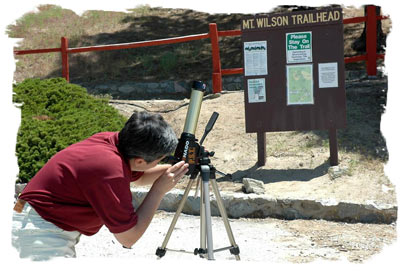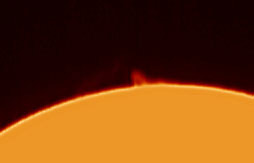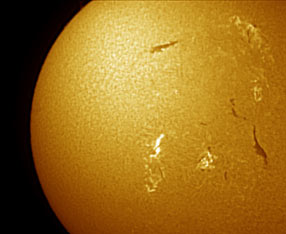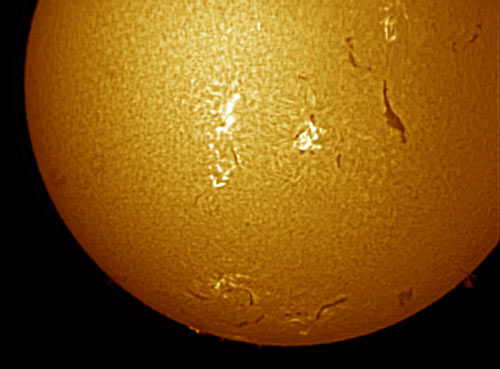| Personal Solar Telescope PST | ||||||||||||||||||||||||||||||||||||||
| With the new arrival of this low cost H-alpha telescope made by Coronado, amateurs can jump into the fascinating world of the active sun. |  |
|||||||||||||||||||||||||||||||||||||
PST and Solar Max 40 |
||||||||||||||||||||||||||||||||||||||
| During a trip to the USA, in California, to visit and to give a presentation at the SAS meeting, I finally decided to buy a Personal Solar Telescope there.
I bought it at Opt Corp, Oceanside: "No problem, if I do not like it, you can bring it back", said Mike West, the vendor. But guess what ? I did not bring it back. You can order by phone or by internet, but for Coronado/Meade products, they do not ship outside US. Even more, during the Riverside Telescope Maker Conference, I spent even more dollars to buy a Solar Max 40 to stack on top of the PST. See our visit in US here |
||||||||||||||||||||||||||||||||||||||
 |
||||||||||||||||||||||||||||||||||||||
 |
||||||||||||||||||||||||||||||||||||||
|
During our visit, we found several occasion to visually test it on the sky. The sun is supposed to be in its minimum activity period, but this year was still a very active year. And in H-apha, the evolutions of the features is easely seen in a less than hour period... |
||||||||||||||||||||||||||||||||||||||
 |
||||||||||||||||||||||||||||||||||||||
During our stay to L.A. we paid a visit to our friends, Sandrine and Didier Favre. Didier is also an astronome amateur and he is specialized in H-alpha observation. He owns a SM60 and produces great images from the parking lot of their residence...
|
||||||||||||||||||||||||||||||||||||||
| On the parking lot of the Mount Wilson observatory in the mountains above Los Angeles | ||||||||||||||||||||||||||||||||||||||
The image and its limitations... |
||||||||||||||||||||||||||||||||||||||
The addition of the Solar max is a real plus. It decrease overall brightness of the image, but the bandpass of the filter being smaller, the contrast is really better.
|
 |
|||||||||||||||||||||||||||||||||||||
|
One of my first image 1:2 scale - standard webcam with color CCD. The structure of the CCD is visible and the noise is high. Nevertheless, one can see two actives regions and a proeminence. Paris area, 5th June 2005
|
||||||||||||||||||||||||||||||||||||||
 |
||||||||||||||||||||||||||||||||||||||
Webcam and CCD... |
||||||||||||||||||||||||||||||||||||||
| It is quite simple to use a webcam to record images. By stacking them you can reduce the noise and even select the best from a sequence. But the standard CCD are not so sensitive in the red of the H-alpha and the structure of the CCD, with fixe pattern noise is quite annoying.
Using a black and white CCD which has been installed instead of the standard one produce a much better image quality. The difference is really impressive. |
||||||||||||||||||||||||||||||||||||||
|
a 1:1 ratio of the top proeminences
Paris area, 5th June 2005 |
||||||||||||||||||||||||||||||||||||||
 |
||||||||||||||||||||||||||||||||||||||
 |
||||||||||||||||||||||||||||||||||||||
|
Image taken with a B&W CCD, 1:2 scale
The image is sharper, but the non-uniformity is quite visible on the top left of the solar disk |
||||||||||||||||||||||||||||||||||||||
| The CCD sensor is not large enough to capture the whole solar disk. You need to make a mosaic out of 2 or 3 images.
Due the brightness non-uniformity, the assembly of the image is not perfect. The images are assembled with Photoshop. All the single images are copy paste as calcs. Use the "difference" mode to adjust tehir respective position. When it is done turn back to normal mode. |
||||||||||||||||||||||||||||||||||||||
| B&W Webcam - sum of 100 images - Castanet, 3rd July 2005 - not deflated image a small proeminence can be seen in the bottom right , on the disk and in the space |
||||||||||||||||||||||||||||||||||||||
 |
||||||||||||||||||||||||||||||||||||||
|
Mosaic of 3 images, 3rd July 2005 - Castanet |
||||||||||||||||||||||||||||||||||||||
.jpg) |
||||||||||||||||||||||||||||||||||||||
 |
||||||||||||||||||||||||||||||||||||||
|
Exposure adjusted to increase the contrast of the proeminences - 1/100s for the normal disk image, about 1/50s for the proeminences bottom image |
||||||||||||||||||||||||||||||||||||||
Observations at the Pic du Midi |
||||||||||||||||||||||||||||||||||||||
.jpg) |
||||||||||||||||||||||||||||||||||||||
| Every summer, it is a pleasure to spend several weeks at the Pic du Midi, professional obsevratory. Thanks to the Association T60 and to some friends, we can stay for several days, all dedicated to sky observations in excellent stay conditions. Beside the use of the 60cm telescope during the night, we can install sun instrument on a terrace and also make observations during the day.
The PST + SolarMax 40 is mounted on a GP-DX equatorial mount. You need to put black tissue to prevent entries of light. |
||||||||||||||||||||||||||||||||||||||
.JPG) |
||||||||||||||||||||||||||||||||||||||
|
The PST + SolarMax 40 is mounted on a an equatorial mount, either a GP-DX or an EM-200. You need to put black tissue to prevent entries of light. ALso, to see the PC screen with good contrast... As weather conditions were stable over few days, it was possible to follow the sun features evolutions. And, if you are lucky and patient, a proemiences can also change over one hour, and it is quite interesting to record images of it over this period |
||||||||||||||||||||||||||||||||||||||
 |
||||||||||||||||||||||||||||||||||||||
|
Mosaic of 3 images, 19th of July 2005
A very nice proeminence can be seen on the left and on the top-right |
||||||||||||||||||||||||||||||||||||||
 |
||||||||||||||||||||||||||||||||||||||
 |
||||||||||||||||||||||||||||||||||||||
 |
 |
 |
||||||||||||||||||||||||||||||||||||
 |
||||||||||||||||||||||||||||||||||||||
|
||||||||||||||||||||||||||||||||||||||
 |
||||||||||||||||||||||||||||||||||||||
 |
 |
|||||||||||||||||||||||||||||||||||||
|
On the left, composition of 3 images with a small B&W sensor
On the right, composition of 2 images taken with a larger B&W sensor camera borrowed to Sylvan Rondi The image on the right is crisper and more uniform. A composition using overexposed images to get the proeminences has been done here too |
||||||||||||||||||||||||||||||||||||||
 |
||||||||||||||||||||||||||||||||||||||
 |
 |
|||||||||||||||||||||||||||||||||||||
 |
||||||||||||||||||||||||||||||||||||||
| 25th of august 2005 - On the left, composition of 3 images - On the top right, one of the single image - On the bottom right a composition of 5 images taken with a barlow | ||||||||||||||||||||||||||||||||||||||
|
The colorisation of the presented images is done with photoshop, using a color curve file. Get the file and explanations from Gregory Giuliani site here |
||||||||||||||||||||||||||||||||||||||
 |
 |
|||||||||||||||||||||||||||||||||||||
 |
||||||||||||||||||||||||||||||||||||||
| Protuberances evolution - 25th of august 2005 - PST + SM40 - Pic du Midi | ||||||||||||||||||||||||||||||||||||||
 |
||||||||||||||||||||||||||||||||||||||
| With Christian Buil - the author of Iris | ||||||||||||||||||||||||||||||||||||||